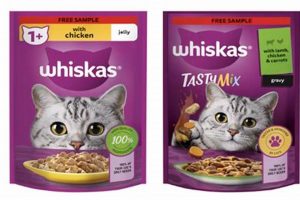Celiac disease and gluten sensitivities necessitate dietary modifications. Vietnamese cuisine, with its emphasis on fresh herbs, rice noodles, and flavorful broths, offers numerous options for individuals avoiding gluten. Many traditional dishes are naturally devoid of gluten-containing ingredients like wheat, barley, and rye. A common example is Pho, a noodle soup typically made with rice noodles, broth, herbs, and meat.
Adhering to a gluten-free regimen while enjoying Vietnamese fare contributes to improved digestive health and symptom management for those with sensitivities. The prevalence of rice as a staple ingredient and the traditional use of rice flour-based alternatives significantly broaden dietary choices. Historically, Vietnamese cooking has relied heavily on rice-based products due to the region’s agricultural practices.
Navigating a gluten-free diet within Vietnamese cuisine requires understanding ingredient substitutions and potential cross-contamination risks. The following sections will delve into specific dishes, ingredient alternatives, and restaurant dining strategies to ensure a safe and enjoyable culinary experience.
Successfully enjoying Vietnamese food while avoiding gluten necessitates careful consideration of ingredients and preparation methods.
Tip 1: Verify Noodle Composition: Rice noodles are typically gluten-free, however, confirm that they are exclusively made from rice flour. Some manufacturers may add wheat flour.
Tip 2: Investigate Sauce Ingredients: Soy sauce, a common Vietnamese condiment, often contains wheat. Opt for tamari, a gluten-free soy sauce alternative, or coconut aminos.
Tip 3: Inquire About Broth Preparation: Some broth recipes may incorporate wheat-based thickeners or flavor enhancers. Directly inquire about the broth’s ingredients.
Tip 4: Avoid Fried Foods Without Confirmation: Fried spring rolls or other battered items may utilize wheat flour. Confirm the batter’s composition prior to consumption.
Tip 5: Be Mindful of Cross-Contamination: Communicate dietary restrictions clearly to restaurant staff. Request that food be prepared separately to prevent cross-contamination.
Tip 6: Look for Gluten-Free Menu Options: Many Vietnamese restaurants are now offering dedicated gluten-free menus or clearly marking gluten-free dishes.
Tip 7: Explore Rice Paper Rolls: Fresh spring rolls, wrapped in rice paper, provide a naturally gluten-free option. Ensure the dipping sauce is also gluten-free.
These precautions enable individuals to confidently enjoy the diverse flavors of Vietnamese cuisine while adhering to dietary restrictions.
The next section will explore specific Vietnamese dishes that are typically gluten-free or can be easily modified to be so.
1. Rice Noodle Varieties
The availability of diverse rice noodle varieties is fundamentally linked to the viability of gluten-free Vietnamese cuisine. Rice noodles, crafted exclusively from rice flour and water, provide a naturally gluten-free alternative to wheat-based noodles, which are strictly prohibited in a gluten-free diet. This substitution is not merely a replacement; it is a defining characteristic that allows numerous Vietnamese dishes to be adapted for individuals with celiac disease or gluten sensitivities. For example, Pho, a traditionally wheat-noodle-based dish in some regional variations, becomes accessible when prepared with rice noodles, expanding the culinary options for those on restricted diets. Without the diversity of rice noodle types from thin vermicelli to wide rice sheets the scope of gluten-free Vietnamese cuisine would be significantly limited.
The specific type of rice noodle used also influences the overall dish. Pho utilizes flat rice noodles, while Bun Cha requires thin rice vermicelli. These variations in texture and shape contribute to the distinct characteristics of each dish. Understanding these differences allows for accurate ingredient selection and preparation, essential for achieving authentic flavors and textures in gluten-free adaptations. Restaurants specializing in gluten-free Vietnamese food often highlight the specific rice noodle variety used in each dish to ensure transparency and build consumer confidence.
In summary, rice noodle varieties are not simply an ingredient in gluten-free Vietnamese food; they are a cornerstone of its existence. The availability of these alternatives enables the creation of numerous dishes that would otherwise be inaccessible to those avoiding gluten. This understanding underscores the critical role of rice noodles in expanding dietary options and ensuring that individuals with dietary restrictions can still enjoy the rich flavors and culinary traditions of Vietnamese cuisine.
2. Sauce Ingredient Awareness
Sauce ingredient awareness is a critical component of maintaining a gluten-free diet while enjoying Vietnamese cuisine. Many traditional Vietnamese sauces contain ingredients derived from wheat or are produced in facilities where cross-contamination is prevalent. Consequently, meticulous scrutiny of sauce components is required to ensure dietary compliance and prevent adverse reactions.
- Soy Sauce and Its Alternatives
Traditional soy sauce is often fermented using wheat, making it unsuitable for a gluten-free diet. Tamari, a fermented soy sauce that is typically wheat-free, and coconut aminos, derived from coconut sap, are viable alternatives. Examining product labels to verify the absence of wheat is crucial when selecting soy sauce substitutes. Restaurants should be queried regarding the specific brand and ingredients of soy sauce used in their dishes.
- Fish Sauce Considerations
While fish sauce is inherently gluten-free as it is made from fermented fish, salt, and water, potential contamination can occur during the manufacturing process. Certain producers may add wheat-based ingredients as stabilizers or preservatives. Selecting reputable brands that explicitly state their fish sauce is gluten-free mitigates this risk.
- Hoisin Sauce Scrutiny
Hoisin sauce frequently contains wheat flour as a thickening agent. Gluten-free versions of hoisin sauce are available, substituting rice flour or cornstarch for wheat. Careful label examination is essential to confirm the absence of wheat-based ingredients.
- Dipping Sauce Diligence
Nuoc Cham, a popular Vietnamese dipping sauce, typically consists of fish sauce, lime juice, sugar, and chili peppers. Ensuring the fish sauce used is gluten-free is paramount. Additionally, scrutinizing other potential additives, such as modified food starch, is necessary to confirm the absence of gluten-containing components.
These considerations underscore the importance of proactive engagement with ingredient information when dining out or preparing Vietnamese food at home. Diligent ingredient assessment provides assurance of adherence to a gluten-free regimen and enhances the overall dining experience.
3. Cross-Contamination Prevention
In the context of gluten-free Vietnamese food, the prevention of cross-contamination is paramount. Despite naturally gluten-free ingredients in many Vietnamese dishes, improper food handling can introduce gluten, rendering the meal unsuitable for individuals with celiac disease or gluten sensitivity. A focus on prevention is, therefore, essential to ensuring safe consumption.
- Utensil Segregation
The use of shared cooking utensils presents a significant risk of cross-contamination. If the same spatula, tongs, or cutting board is used for both gluten-containing and gluten-free foods, gluten particles can transfer to the gluten-free dish. Restaurants must designate separate utensils for preparing gluten-free meals. Within a home kitchen, dedicated gluten-free utensils should be clearly marked and stored separately.
- Cooking Surface Management
Cooking surfaces, such as grills, stovetops, and woks, can harbor gluten residue from previous meals. Before preparing gluten-free Vietnamese food, these surfaces must be thoroughly cleaned to remove any traces of gluten. Utilizing dedicated gluten-free cookware, such as pots and pans, further reduces the risk of cross-contamination.
- Oil and Sauce Separation
Shared frying oil can become contaminated with gluten if used to cook breaded or battered items. Gluten-free Vietnamese dishes should only be fried in oil that has not been used to cook gluten-containing food. Similarly, shared sauce containers can become contaminated through repeated dipping of gluten-containing items. Individual condiment packets or dedicated gluten-free sauce containers should be provided.
- Ingredient Storage Practices
Improper ingredient storage can lead to cross-contamination in the pantry. Gluten-free flours and starches should be stored in airtight containers and kept separate from gluten-containing items like wheat flour. When scooping ingredients, dedicated utensils should be used to prevent cross-transfer of gluten particles.
Effective cross-contamination prevention requires diligent adherence to strict food handling protocols. Implementing these measures enables individuals with gluten sensitivities to safely enjoy the flavors of Vietnamese cuisine, highlighting the necessity of meticulous preparation in both commercial and domestic settings.
4. Naturally Gluten-Free Dishes
The inherent composition of certain Vietnamese dishes renders them naturally devoid of gluten, providing readily available options for individuals adhering to a gluten-free diet. These dishes rely on ingredients that do not contain wheat, barley, or rye, the primary sources of gluten. Understanding which dishes fall into this category simplifies dietary planning and minimizes the risk of inadvertent gluten consumption.
- Gi cun (Fresh Spring Rolls)
Fresh spring rolls, also known as summer rolls, consist of rice paper wrappers filled with rice vermicelli, fresh herbs, vegetables, and protein sources such as shrimp or pork. As the rice paper and vermicelli are derived from rice, and the other ingredients are naturally gluten-free, Gi cun offers a safe and refreshing option. The accompanying dipping sauce may require scrutiny to ensure it does not contain gluten-containing soy sauce.
- Ph (Rice Noodle Soup – with appropriate noodles)
Ph, a staple Vietnamese soup, traditionally features rice noodles in a flavorful broth with meat and herbs. When prepared with 100% rice noodles, Ph is inherently gluten-free. However, it is imperative to confirm that the noodles are exclusively made from rice flour and that the broth does not contain any wheat-based thickeners or soy sauce. Clear communication with the restaurant is essential to ensure gluten-free preparation.
- Bn ch (Rice Vermicelli with Grilled Pork)
Bn ch consists of grilled pork served over rice vermicelli noodles with fresh herbs and dipping sauce. The rice vermicelli is naturally gluten-free, and the grilled pork is typically marinated in gluten-free ingredients. The dipping sauce is the primary area of concern, necessitating verification of the absence of gluten-containing soy sauce. When the dipping sauce is prepared using fish sauce, lime juice, sugar, and water with no soy sauce, it is gluten-free.
- Cm tm (Broken Rice)
Cm tm, a popular dish featuring broken rice, is inherently gluten-free. It is typically served with grilled pork chops, shredded pork skin, and a fried egg. While the rice itself is safe, the accompaniments, particularly any sauces or marinades used on the pork chops, should be checked for gluten-containing ingredients. Ensuring that the sauces are free of wheat and soy sauce, the dish can be enjoyed as a naturally gluten-free option.
These naturally gluten-free dishes exemplify the accessibility of Vietnamese cuisine for individuals avoiding gluten. They underscore the importance of ingredient awareness and communication with food preparers to guarantee the absence of gluten-containing additives in sauces and accompaniments. Furthermore, they highlight the ease with which one can adapt and enjoy Vietnamese flavors within the confines of a gluten-free diet.
5. Modified Recipes Adaptability
Modified recipes adaptability is central to expanding the range of gluten-free Vietnamese food. While some dishes are inherently gluten-free, others require adjustments to eliminate gluten-containing ingredients. The successful adaptation of these recipes hinges on a thorough understanding of traditional Vietnamese cuisine and the ability to identify and replace problematic ingredients without compromising flavor profiles. The cause is the presence of gluten in traditionally prepared Vietnamese dishes, and the effect is the need for recipe modification to cater to gluten-free diets. Without this adaptability, the options for those with celiac disease or gluten sensitivities would be severely limited.
One practical example is the substitution of tamari or coconut aminos for traditional soy sauce in dishes like stir-fries and dipping sauces. Traditional soy sauce contains wheat, a prohibited ingredient for those avoiding gluten. Another example is using rice flour or tapioca starch as a thickening agent in sauces and soups, replacing wheat flour or cornstarch, which may be processed in facilities that also handle wheat. Banh Xeo (Vietnamese crepes), traditionally made with a batter containing wheat flour, can be modified using rice flour and tapioca starch to create a gluten-free version that maintains the desired texture and flavor. The practical significance is that more complex dishes, not naturally gluten-free, become accessible.
In summary, modified recipes adaptability is not merely a supplementary aspect but an integral component of creating a diverse and inclusive gluten-free Vietnamese food landscape. This adaptability overcomes the inherent limitations of traditional recipes, allowing individuals with dietary restrictions to enjoy a wider range of Vietnamese culinary experiences. Challenges remain in ensuring authenticity and preserving the original flavors while adhering to gluten-free principles, but ongoing innovation and awareness continue to expand the possibilities.
Frequently Asked Questions
This section addresses common inquiries regarding the feasibility and implementation of a gluten-free diet within the context of Vietnamese culinary practices. These answers provide clarity and guidance for individuals with celiac disease or gluten sensitivities.
Question 1: Is all Ph inherently gluten-free?
While traditional Ph utilizes rice noodles, which are naturally gluten-free, verification of the noodle composition is critical. Certain manufacturers may incorporate wheat flour as a binding agent. Moreover, some broth recipes may include wheat-based thickeners or soy sauce, which typically contains wheat. Direct inquiry regarding the ingredients used in both the noodles and the broth is essential.
Question 2: What are reliable alternatives to soy sauce in Vietnamese cuisine?
Traditional soy sauce contains wheat, rendering it unsuitable for a gluten-free diet. Tamari, a fermented soy sauce made without wheat, and coconut aminos, derived from coconut sap, provide acceptable substitutes. Careful examination of product labels is recommended to ensure the absence of wheat or cross-contamination.
Question 3: How can cross-contamination be minimized when dining at a Vietnamese restaurant?
Clear communication with restaurant staff is paramount. Explicitly state the requirement for gluten-free preparation. Request that food be prepared using separate utensils and cooking surfaces to prevent cross-contamination. Inquire about the ingredients of sauces and marinades to confirm the absence of gluten-containing components. Choosing restaurants with dedicated gluten-free menus reduces the risk.
Question 4: Are Vietnamese spring rolls a safe gluten-free option?
Fresh spring rolls (Gi cun), wrapped in rice paper, are generally safe as the wrapper is made from rice. However, fried spring rolls present a risk, as the batter may contain wheat flour. Always confirm the ingredients of the spring roll filling and, most importantly, the batter of fried spring rolls. Additionally, examine the dipping sauce for soy sauce or other gluten-containing components.
Question 5: Is fish sauce inherently gluten-free?
In its pure form, fish sauce, comprised of fermented fish, salt, and water, is gluten-free. However, some manufacturers add wheat-based ingredients as stabilizers or preservatives. Selecting reputable brands that explicitly state “gluten-free” on the label is advised.
Question 6: What steps should be taken when preparing Vietnamese food at home to ensure it is gluten-free?
Thoroughly clean all cooking surfaces and utensils to eliminate potential gluten residue. Utilize dedicated gluten-free cutting boards, cookware, and storage containers. Carefully read product labels to confirm the absence of gluten in all ingredients, including sauces, marinades, and spices. Substitute tamari or coconut aminos for soy sauce. Exercise caution when using shared frying oil or sauce containers to prevent cross-contamination.
These frequently asked questions serve to clarify common misconceptions and provide actionable steps for navigating a gluten-free diet within the realm of Vietnamese cuisine. Adherence to these guidelines will enable individuals to enjoy the flavors of Vietnam while minimizing the risk of gluten exposure.
The subsequent section will provide a comprehensive resource list for gluten-free Vietnamese cuisine, including restaurant directories and online recipe resources.
Conclusion
The exploration of gluten free vietnamese food reveals a landscape of both opportunity and caution. While Vietnamese cuisine boasts numerous inherently gluten-free elements, the prevalence of hidden gluten sources necessitates vigilant ingredient scrutiny and preparation awareness. Successfully navigating this culinary terrain demands a comprehensive understanding of noodle composition, sauce ingredients, and cross-contamination risks. It also requires the ability to identify naturally gluten-free dishes and adapt recipes to eliminate gluten-containing components.
The information presented should serve as a foundational resource for individuals seeking to enjoy Vietnamese flavors while adhering to a gluten-free diet. Prioritizing informed decision-making, coupled with proactive communication with restaurant personnel or diligent home preparation, ensures a safe and satisfying culinary experience. Continued awareness and transparency within the food industry are essential to further expand and enhance the accessibility of gluten free vietnamese food options for all.




![Best Gluten Free Fast Food French Fries [Guide + List] World’s Most Delicious Foods: Must-Try Dishes from Every Country Best Gluten Free Fast Food French Fries [Guide + List] | World’s Most Delicious Foods: Must-Try Dishes from Every Country](https://lisasfoods.com/wp-content/uploads/2025/12/th-787-300x200.jpg)


